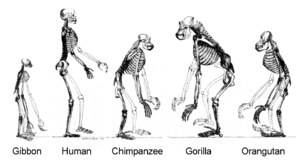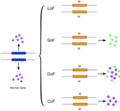Portal:Evolutionary biology
Introduction
Selected article - Lamarckism, also known as Lamarckian inheritance or neo-Lamarckism, is the notion that an organism can pass on to its offspring physical characteristics that the parent organism acquired through use or disuse during its lifetime. It is also called the inheritance of acquired characteristics or more recently soft inheritance. The idea is named after the French zoologist Jean-Baptiste Lamarck (1744–1829), who incorporated the classical era theory of soft inheritance into his theory of evolution as a supplement to his concept of orthogenesis, a drive towards complexity. Introductory textbooks contrast Lamarckism with Charles Darwin's theory of evolution by natural selection. However, Darwin's book On the Origin of Species gave credence to the idea of heritable effects of use and disuse, as Lamarck had done, and his own concept of pangenesis similarly implied soft inheritance. (Full article...) General images -The following are images from various evolutionary biology-related articles on Wikipedia.
Selected picture - The hominoids are descendants of a common ancestor. Did you know... -
CategoriesRelated portalsTasks you can do
Related topicsWikiProjectsWikiProjects connected with biology: A complete list of scientific WikiProjects can be found here. See also Wikispecies, a Wikimedia project dedicated to classification of biological species. Associated WikimediaDiscover Wikipedia using portals |
























![Image 24A covalent adduct between the metabolite of benzo[a]pyrene, the major mutagen in tobacco smoke, and DNA (from Mutation)](/uploads/wikipedia/commons/thumb/d/d8/Benzopyrene_DNA_adduct_1JDG.png/87px-Benzopyrene_DNA_adduct_1JDG.png?auto=webp)
























